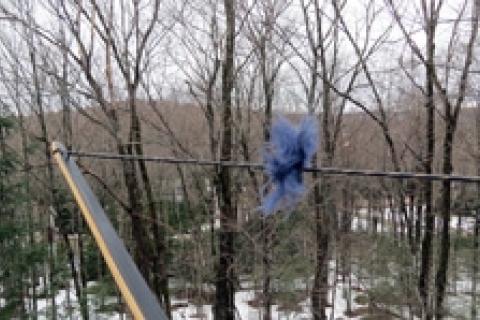
You don't need to be an experienced bow hunter to understand the benefits of a quiet bow. Noisy bows can, on the draw or release, alert game animals to the imminent arrival of an arrow and sometimes contribute to the animal jumping the string.
 |
| A string silencer, shown above, is one of a couple options to help silence your shot. |
For those unfamiliar with the term, jumping the string describes what happens when an animal detects an incoming arrow and reacts, generally by ducking quickly. They aren't necessarily ducking the arrow so much as reflexively loading muscles to get the heck out of there. Whatever they're doing, jumping the string often results in a miss or, on occasion, a bad hit — the animal is simply not in the same location when the arrow arrives. Needless to say, this is undesirable.
Modern compound bows with their many components and greater arrow speeds are, for the most part, inherently louder than traditional bows. But that doesn't mean that traditional archers shouldn't worry about this issue.
Fortunately, silencing a bow is a relatively easy thing to do. But, as always, there are tradeoffs and things to consider.
First, a heavier arrow is quieter than a lighter one. Wooden arrows are heavier than aluminum and aluminum are heavier than carbon. Before you go out and buy a dozen wooden arrows, however, you should also know that, all things being equal, wooden arrows shoot slowest of the three and carbon quickest. That's not necessarily a great disadvantage with traditional gear, especially at the ranges we shoot at; however, it's just something you ought to know before deciding.
The next thing you ought to understand is, as a rule, the heavier the bowstring the quieter and slower it is. Typically modern, low-stretch materials are noisier. But they're also lighter and therefore faster. Again, there's no judgment here. Some archers don't mind trading off a little noise for a little more arrow speed.
Lastly, a well tuned bow is quieter than one that's out of tune. Though you shouldn't need one, this is another very good argument for ensuring that your bow is in tune.
So the first thing to do then is choose the arrow and bowstring you want to go with. Then tune your bow accordingly. That means twisting bowstrings to get the right brace height and adjusting nocking points so the arrow doesn't collide with your shelf or rest. It's a little more complicated than that, so it is probably best suited as the subject of a future blog entry. But any good archery pro shop can help you tune a bow.
Once you've figured these things out and before you begin bow tuning, I'd strongly recommend string silencers of one type or another. You lose a few feet per second on arrow speed but they drop noise levels significantly. On a recurve bow, it's also a good idea to add mole skin patches to the belly of the bow (the side facing you) at the tips where the string makes contact. This prevents string slap.
If you shoot off of a rest you should also line the shelf and handle where the arrow makes contact with moleskin or the soft part of Velcro. This makes it quieter on the draw and release. If you are using a rest, make sure it's relatively quiet.
This minor investment in bow tuning makes a major difference in a hunting situation.
- 3652 views

